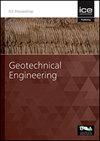高压气体作用下层状岩体应力波传播特性
IF 1.7
4区 工程技术
Q3 ENGINEERING, GEOLOGICAL
Proceedings of the Institution of Civil Engineers-Geotechnical Engineering
Pub Date : 2023-02-13
DOI:10.1680/jgeen.22.00116
引用次数: 0
摘要
高压气体爆破作为一种高度安全、环保的爆破技术,在一些工程领域已经取代了传统的炸药爆破。本文采用实验和数值模拟的方法研究了高压瓦斯爆破作用下层状岩体中高压瓦斯冲击载荷的特性和应力波的传播规律。首先,通过孔壁压力的实验测试,提出了高压气体作用下孔壁压力的分段指数模型,该模型能够准确地反映高压气体作用下孔壁载荷的时程特征。其次,进行了应力波传播的实验测试,结果表明,软、硬岩体界面对应力波在层状岩体中的传播有显著影响。在试验测试结果的基础上,拟合了单孔层状岩体在10 MPa高压气体冲击下的特定应变模型,提出了多项式指数模型形式,拟合了双孔层状岩体在20 MPa高压气体冲击下的特定应变模型,较好地表征了单孔和双孔层状岩体应力波的衰减规律。初步分析了高压气体作用下层状岩体中应力波的传播特性。最后,建立了与应力波传播实验结果一致的数值模型。数值模型采用具有试验参数的RHT材料模型,将所提出的孔壁压力分段指数模型分别应用于炮眼下部、中部和上部。在分析数值模型可行性的基础上,以某地下管廊工程为例,通过数值模拟进一步研究了应力波的传播特性。该研究对完善层状岩体高压瓦斯爆破破岩理论和优化施工方案具有重要的理论指导意义和实用价值。本文章由计算机程序翻译,如有差异,请以英文原文为准。
Propagation characteristics of stress wave in layered rock mass under the impact of high-pressure gas
As a highly safe and environment-friendly blasting technology, high-pressure gas blasting has replaced traditional explosive blasting in some engineering fields. This paper focuses on the characteristics of high-pressure gas impact load and the propagation law of the stress wave in layered rock mass under high-pressure gas blasting by experimental and numerical simulation methods. Firstly, through the experimental test of hole wall pressure, a segmented exponential model of the hole wall pressure under the impact of high-pressure gas is proposed, which can accurately account for the time history characteristics of hole wall load under the impact of high-pressure gas. Next, the experimental test of stress wave propagation is carried out, and the results show that the interface of soft rock and hard rock has a significant effect on the stress wave propagation in the layered rock mass. Based on the experimental test results, a specific strain model under 10 MPa high-pressure gas impact is fitted for single-hole layered rock mass, and a polynomial exponential model form is put forward and a specific strain model under 20 MPa high-pressure gas impact is fitted for the double-hole layered rock mass, which can well characterize the attenuation law of the stress wave for single-hole and double-hole layered rock mass respectively. The propagation characteristics of stress wave in layered rock mass under the impact of high-pressure gas are preliminary analyzed. Finally, a same numerical model consistent with the experimental test of stress wave propagation is established. The numerical model adopts the RHT material model with the tested parameters, and the proposed segmented exponential models of hole wall pressure are applied to the lower, middle and upper parts of the blasthole respectively. After the feasibility of the numerical model is analyzed, the propagation characteristics of the stress wave are further studied based on a specific underground pipe gallery project by numerical simulation. This study has important theoretical guiding significance and practical value for improving the rock breaking theory and optimizing the construction scheme of high-pressure gas blasting in layered rock mass.
求助全文
通过发布文献求助,成功后即可免费获取论文全文。
去求助
来源期刊
CiteScore
4.40
自引率
4.50%
发文量
68
审稿时长
3 months
期刊介绍:
Geotechnical Engineering provides a forum for the publication of high quality, topical and relevant technical papers covering all aspects of geotechnical research, design, construction and performance. The journal aims to be of interest to those civil, structural or geotechnical engineering practitioners wishing to develop a greater understanding of the influence of geotechnics on the built environment.

 求助内容:
求助内容: 应助结果提醒方式:
应助结果提醒方式:


